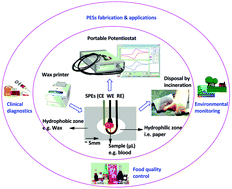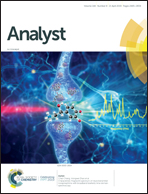Recent advances in and potential utilities of paper-based electrochemical sensors: beyond qualitative analysis
Abstract
Paper-based electrochemical sensors (PESs) have been evidenced as analytical strategies for employing simple, low-cost, portable and disposable sensing platforms that can be used in many application areas. Recently, PESs have gained extensive attention because of their advantages of advanced sensitivity and selectivity during detection provided by electrochemistry, compared with microfluidic paper-based analytical devices (μPADs) that still lack these advantages. Also, it can be expected that PESs can better meet current user demands, making them a stand-out analytical tool because of their capability for multiple analyte detection and their compatibility in a variety of application areas, like clinical diagnosis, environmental monitoring and food quality control. Herein, in this mini review, we present an overview of recent developments in PESs over the last decade, focusing on existing fabrication techniques and application areas, specifically in relation to clinical diagnostics, food quality control and environmental monitoring, where simple and portable analytical devices are greatly needed. A summary and future outlooks for PESs are also discussed.

- This article is part of the themed collection: Recent Review Articles


 Please wait while we load your content...
Please wait while we load your content...